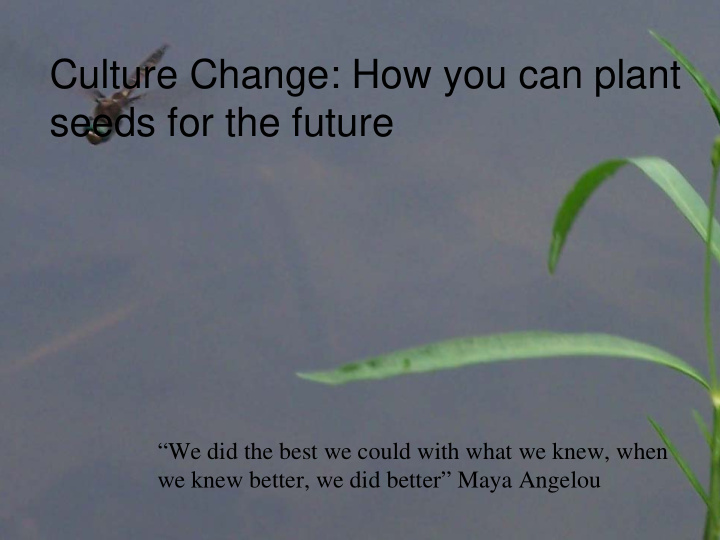



Culture Change: How you can plant seeds for the future “We did the best we could with what we knew, when we knew better, we did better” Maya Angelou
What is Culture Change? • Transforming long-term care facilities through Person-Directed Values and Practices where the voices of the Individual Residents, and those closest to them, are honored and respected.
This Horse Won’t Go! • The proverbial dead horse
What we do when we discover we are riding a dead horse - • Buy a stronger whip • Change riders • Say “this is the way we’ve always ridden a dead horse” • Appoint a committee to study the dead horse • Arrange a visit to see how others ride dead horses • Create an education program to improve riding skills • Declare “this horse is not dead” • Promote the horse to a supervisory position
Culture Change Value statements – Know each person – Each person can and does make a difference – Relationships are the fundamental building block of a transformed culture – Respond to the spirit, as well as mind and body – Risk taking is a normal part of life. – Put the Person before the task
Value Statements continued – All Individuals are entitled to self- determination, independence and choice wherever they live – Community is the cure for institutionalization – Promote the growth and development of everyone in the facility. – Recognize that culture change and transformation are not destinations but a journey, always a work in progress
Old system Vs. Culture Change • Breakfast- residents • Breakfast- served at get up early and wait the time a resident in the dining room requests it. • Bathing- Showers with • Bathing- use of hoses and stalls, whirlpool, towel hurried so everyone warmers, relaxed gets finished enjoyable time • Staff- rotating staff • Staff- same staff so always a new face relationships are developed.
Culture Change Best Practices • 60% reduction of in-house pressure ulcers • 25% reduction in the total number of bedfast residents • 18% reduction in the use of restraints • 87% reduction in use of anti-anxiety PRN meds • 100% reduction in use of routine anti-psychotics • 100% reduction in the use of sedative hypnotics
Culture Change Best Practices • 73% reduction of incident reports • 7% increase in self-administration of meds • 50% increase of residents’ activity levels • greater than 100% increase in social interactions involving residents • 59% reduction in staff absenteeism (the leading overall cause of employee termination) • greater than 35% reduction in turnover (the average facility spends around $250,000 each year on employee turnover, so a savings of $35% translates to more than $85,000 --not to mention money saved from reducing agency staffing and sign-on bonuses, which were eliminated)
Ombudsman work to ensure… • Individuals who live in LTC facilities will exercise their rights and make choices that will enable them to function at their highest level and enjoy life to its fullest – whatever they determine that to be.
Focus of the Ombudsman program 1. Resident empowerment 2. Awareness of Residents’ rights 3. Education for families about LTC 4. Awareness and education about the Ombudsman program 5. Share tools/ideas for facilities to improve
Federal Nursing Home Regulations that support Culture Change • 483.15 Quality of life . A facility must care for its residents in a manner and in an environment that promotes maintenance or enhancement of each resident's quality of life. • (a) Dignity . The facility must promote care for residents in a manner and in an environment that maintains or enhances each resident's dignity and respect in full recognition of his or her individuality. • (b) Self-determination and participation .
Federal Regulations • The resident has a right to a dignified existence, self-determination, and communication with and access to persons and services inside and outside the facility. 483.10
IMAGINE Facilities where people go to live, grow and learn Staff turnover is no longer a problem Having a waiting list for residents and staff members The type of facility you want to live in if you need long-term care.
How can you promote Culture Change? • Join your state Culture Change Coalition • Educate yourself and others • Start with small things • Share your ideas for improving the Quality of Life for Residents • Ask Residents for input on changes before implementation • Work to make this facility somewhere that you would like to live • Contact mlakespencer@nccnhr.org for more information about Culture Change
Let no one come to you, without leaving better and happier. Mother Teresa
Culture Change resources • Pioneer Network • “Old Age in the New Age Beth Baker • Books by William Thomas, MD • Joanne Rader “ Bathing without a battle” • NCCNHR- The National Voice for Quality Long-term Care • National Ombudsman Resource Center
Recommend
More recommend